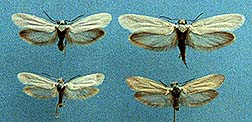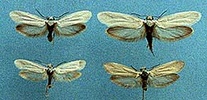Tegeticula altiplanella
Olle PellmyrAdult Characteristics
Wing expanse 18-27.5 mm. Forewing white, and hindwing dark brownish grey, darkest by fore edge and apex, gradually lighter toward back corner; generally lighter in southernmost populations. Some indidivuals with tan forewing coloration, primarily at higher elevation and in northern part of species range. Male genitalia with aedeagus 1.70-1.85 mm long, 0.03-0.04 mm in cross section; female genitalia with posterior apophyses 6.3-6.5 mm long, corpus bursae with signa 0.60-0.80 mm in diameter.
Comparison with Similar Species
Similar to many species in the yuccasella complex, but readily distinguished from other members of the complex based on genitalic characters. A diagnostic key is provided. Tan forewing coloration is some specimens is shared with the partly sympatric baccatella and with yuccasella.
Host, Oviposition, and Larval Feeding Habits
The species is known from the capsular-fruited yuccas Yucca baileyi (Y. intermedia, Y. navajoa, Y. standleyi), Y. harrimaniae (Y. gilbertiana, Y. neomexicana) and Y. angustissima (Y. kanabensis). Females oviposit into flowers (Pellmyr 1999). Eggs are laid inside the ovary, between the wall and the ovules. The larva feeds on developing seeds. Pupation occurs in a cocoon in the soil.
Geographic Distribution
Mountains and high plains of Colorado, southern Utah, and northern Arizona and New Mexico.


Habitat
Major habitat types include high brush desert, rock outcrops and volcanic tuff soils in open forest, and high grassland. Altitudinal range 1350-2500 m.
References
Pellmyr, O. 1999. Systematic revision of the Tegeticula yuccasella complex (Lepidoptera: Prodoxidae) north of Mexico. Systematic Entomology 24:243-271.
Title Illustrations

| Scientific Name | Tegeticula altiplanella |
|---|---|
| Location | Apache Co, Arizona, USA and San Juan Co, Utah, USA |
| Specimen Condition | Dead Specimen |
| Sex | males and female |
| Image Use |
 This media file is licensed under the Creative Commons Attribution-NonCommercial License - Version 3.0. This media file is licensed under the Creative Commons Attribution-NonCommercial License - Version 3.0.
|
| Copyright |
© 1996

|
About This Page

University of Idaho, Moscow, Idaho, USA
Page copyright © 1996
 Page: Tree of Life
Tegeticula altiplanella .
Authored by
Olle Pellmyr.
The TEXT of this page is licensed under the
Creative Commons Attribution-NonCommercial License - Version 3.0. Note that images and other media
featured on this page are each governed by their own license, and they may or may not be available
for reuse. Click on an image or a media link to access the media data window, which provides the
relevant licensing information. For the general terms and conditions of ToL material reuse and
redistribution, please see the Tree of Life Copyright
Policies.
Page: Tree of Life
Tegeticula altiplanella .
Authored by
Olle Pellmyr.
The TEXT of this page is licensed under the
Creative Commons Attribution-NonCommercial License - Version 3.0. Note that images and other media
featured on this page are each governed by their own license, and they may or may not be available
for reuse. Click on an image or a media link to access the media data window, which provides the
relevant licensing information. For the general terms and conditions of ToL material reuse and
redistribution, please see the Tree of Life Copyright
Policies.
Citing this page:
Pellmyr, Olle. 1996. Tegeticula altiplanella . Version 01 January 1996 (under construction). http://tolweb.org/Tegeticula_altiplanella/12464/1996.01.01 in The Tree of Life Web Project, http://tolweb.org/








 Go to quick links
Go to quick search
Go to navigation for this section of the ToL site
Go to detailed links for the ToL site
Go to quick links
Go to quick search
Go to navigation for this section of the ToL site
Go to detailed links for the ToL site